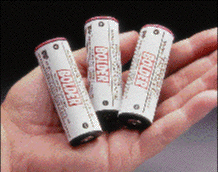1997 Editors' Roundup:
Power sources and connectors
Last year was marked by performance improvements in battery technologies
and the continued miniaturization of all types of power supplies. Similarly,
interconnection products were packing more functionality into a smaller
size while meeting more stringent performance requirements.
Bolder Technologies (Wheat Ridge, CO) introduced a rechargeable lead-acid
battery, designated the TMF (see Electronic Products , Jan. 1997,
p. 17 that uses a patented thin-metal-film technology capable of higher
energy density and longer operating times than a NiCd battery.

Bolder Technologies TMF
Aimed at power tools and other products requiring high power and high
drain rates for short durations, the 2-V, 9/5 sub-C-cell TMF can be recharged
in 15 min at a 30-min charge rate.
Also in batteries, AER Energy Resources (Smyrna, GA) announced development
of a thin zinc-air cell, called the Model 12015 (see Electronic Products ,
Aug. 1997, p. 17), that has an energy density of 170 Wh/kg–50% higher
than Li-ion cells. Suited for portable products requiring long run-times,
the zinc-air cell is nonvolatile, experiences no memory effects, and can
be safely disposed of.
In power supplies, Sierra West Power Systems (Las Cruces, NM) introduced
the first linear power supply available in an encapsulated, board-mountable
package (see Electronic Products , July 1997, p. 74). Called the
Universal Linear Power Module, the patented module combines power FETs
and proprietary drive circuitry, eliminating the need to purchase a complete
linear supply or design one from board-level components.
Miniaturization continues to be a trend not only in low-voltage ac/dc
and dc/dc supplies, but also in high-voltage products. For instance, Emco
High Voltage (Sutter Creek, CA) unveiled its C Series programmable high-voltage
supply that provides up to 4,000 V in a board-mountable package measuring
under 1 in.3 (see Electronic Products , July 1997, p.
78).
Connectors also continue to benefit from miniaturization improvements.
Thomas & Betts (Memphis, TN) introduced the FF-1 Series flexible pc-board
connector (see Electronic Products , Aug. 1997, p. 85), which has
68 contacts spaced 0.5 mm apart on two rows and measures just 1.95 x 5.0
x 2.45 mm.
In fiber-optic connectors, AMP (Harrisburg, PA) designed a high-density
array fiber-optic system, called Lightray MPX, which provides up to 12
fiber interconnections in less space than a single SC connector (see Electronic
Products , Sept. 1997, p. 21). It eases the creation of flexible backplane-based
fiber-optic systems.
Aries Electronics (Frenchtown, NJ) introduced a high-performance RF
socket that exhibits a signal loss of just 1 dB at 10 GHz (see Electronic
Products , Sept. 1997, p. 104). The 64-lead socket has a footprint just
0.250 in. larger on each side than the device footprint.
–Spencer Chin
Advertisement





